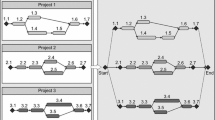Abstract
This paper presents a new model for project portfolio selection, paying specific attention to competence development. The model seeks to maximize a weighted average of economic gains from projects and strategic gains from the increment of desirable competencies. As a sub-problem, scheduling and staff assignment for a candidate set of selected projects must also be optimized. We provide a nonlinear mixed-integer program formulation for the overall problem, and then propose heuristic solution techniques composed of (1) a greedy heuristic for the scheduling and staff assignment part, and (2) two (alternative) metaheuristics for the project selection part. The paper outlines experimental results on a real-world application provided by the E-Commerce Competence Center Austria and, for a slightly simplified instance, presents comparisons with the exact solution computed by CPLEX.
Similar content being viewed by others
References
Brooks F (1975). The mythical man-month. Addison-Wesley, New York
Chen ANK and Edgington TM (2005). Assessing value in organizational knowledge creation: considerations for knowledge workers. MIS Quart 29: 279–309
Coffin MA and Taylor BW (1996). Multiple criteria R&D project selection and scheduling using fuzzy logic. Comput Oper Res 23: 207–220
D’Aveni RA (1994). Hypercompetition: managing the dynamics of strategic maneuvering. The Free Press, New York
Dorigo M and Stützle T (2004). Ant colony optimization. MIT Press, Cambridge
Dreyfus H and Dreyfus S (1986). Mind over machine: the power of human intuition and expertise in the era of the computer. The Free Press, New York
Dutta S, Narasimhan O and Rajiv S (1999). Conceptualizing and measuring capabilities: methodology and empirical application. Strat Manage J 26: 277–285
Erpenbeck J, Heyse V (1999) Kompetenzbiographie—Kompetenzmilieu—Kompetenztransfer. QUEM-Report 62, Berlin
Gutjahr WJ (2006). On the finite-time dynamics of ant colony optimization. Methodol Comput Appl Probab 8: 105–133
Gutjahr WJ, Katzensteiner S, Reiter P (2007) A VNS algorithm for noisy problems and its application to project portfolio analysis. In: Hromkovic J et al (eds) Proceedings SAGA 2007 (Stochastic algorithms: foundations and applications). LNCS, vol 4665. Springer, Heidelberg, pp 93–104
Haesli A and Boxall P (2005). When knowledge management meets HR strategy: an exploration of personalization-retention and codification-recruitment configurations. Int J Human Resour Manage 16: 1955–1975
HR-XML Consortium (2007) Competencies (Measurable Characteristics) Recommendation 2006-02-28. Available at http://ns.hr-xml.org/2_4/HR-XML-2_4/CPO/Competencies.html, last visited: March 30, 2007
Kolisch R and Hartmann S (2006). Experimental investigation of heuristics for resource-constrained project scheduling: an update. Euro J Oper Res 174: 23–37
Kolisch R, Meyer K and Mohr R (2005). Maximizing R&D portfolio value. Res Technol Manage 48: 33–39
Michalewicz Z (1996). Genetic algorithms + data structures = evolution programs. Springer, London
Michalewicz Z, Arabas J (1994) Genetic algorithms for the 0/1 knapsack problem. In: Proceedings of 8th international symposium on methodologies for intelligent systems. LNCS, vol 869. Springer, Heidelberg, pp 134–143
Möhring RH and Stork F (2000). Linear preselective policies for stochastic project scheduling. Math Methods Oper Res 52: 501–515
Ngwenyama O, Guergachi A and McLaren T (2007). Using the learing curve to maximize IT productivity: a decision analysis model for timing software upgrades. Int J Product Econ 105: 524–535
OECD (2006) Main Science and Technology Indicators 2006/2, OECD, Paris
Padman R and Zhu D (2006). Knowledge integration using problem spaces: a study in resource-constrained project scheduling. J Scheduling 9: 133–152
Peteraf MA (2001). The cornerstones of competitive advantage: a resource-based view. Strat Manage J 1: 179–191
Stützle T and Hoos HH (2000). MAX–MIN Ant System. Future Generation Comput Syst 16: 889–914
Venkatraman R and Venkatraman S (1995). R&D project selection and scheduling for organizations facing product obsolescence. R&D Manage 25: 57–70
Wu M-C and Sun S-H (2006). A project scheduling and staff assignment model considering learning effect. Int J Adv Manufact Technol 28: 1190–1195
Author information
Authors and Affiliations
Corresponding author
Rights and permissions
About this article
Cite this article
Gutjahr, W.J., Katzensteiner, S., Reiter, P. et al. Competence-driven project portfolio selection, scheduling and staff assignment. Central Europ J Oper Res 16, 281–306 (2008). https://doi.org/10.1007/s10100-008-0057-z
Published:
Issue Date:
DOI: https://doi.org/10.1007/s10100-008-0057-z




